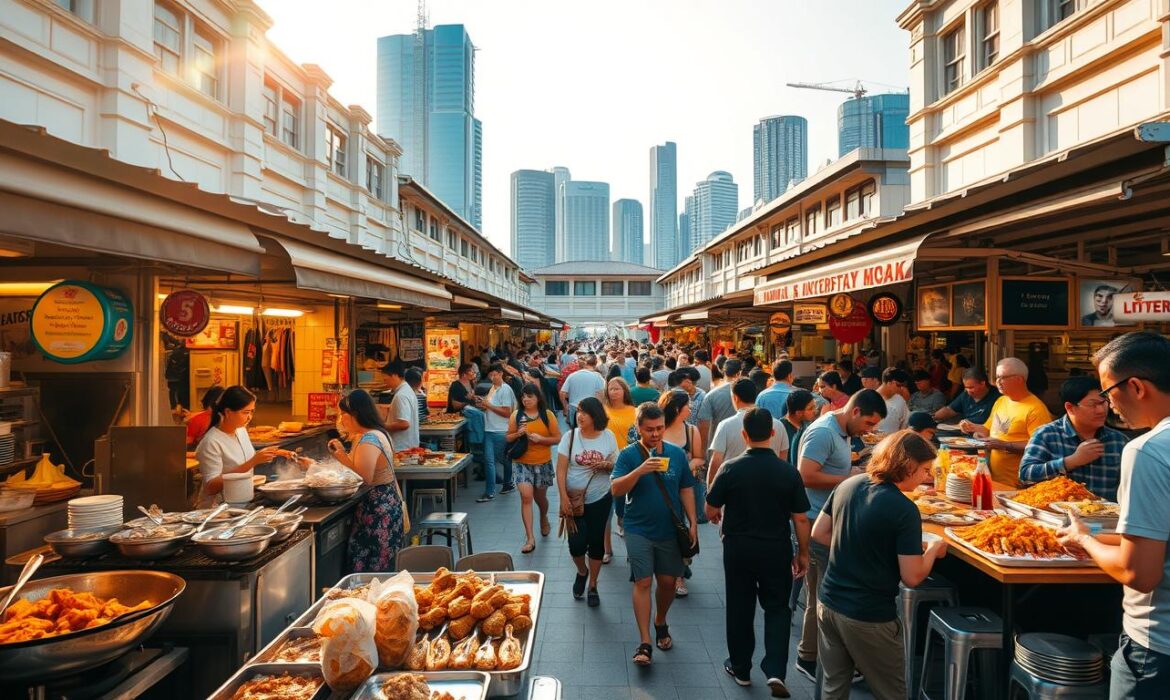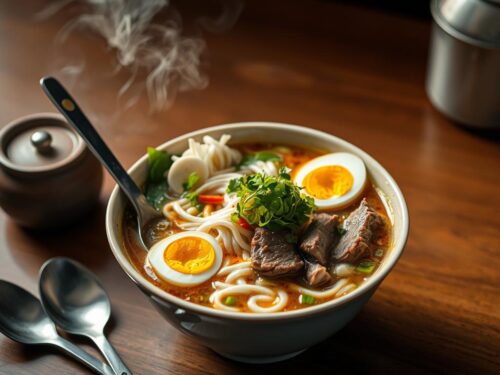Singapore is known worldwide for its vibrant culinary scene. While you won’t find literal street vendors, the city’s hawker centers are where the magic happens. These bustling hubs are cultural institutions, home to generations of skilled cooks who have perfected their craft.
Hawker centers offer a unique blend of flavors, reflecting the multicultural influences of Singapore. From Chinese to Malay and Indian cuisines, every dish tells a story. What’s more, most meals here cost less than $10, making it an affordable way to experience gourmet-level flavors.
Now is the perfect time to explore this culinary treasure. With some hawker stalls facing generational decline, experiencing this culture firsthand is more urgent than ever. Whether you’re a first-time visitor or a local, these 15 iconic dishes are a must-try.
Key Takeaways
- Singapore’s hawker centers are cultural hubs with rich culinary traditions.
- Multicultural influences create a diverse and flavorful food scene.
- Most dishes are affordable, often priced under $10.
- Generational decline makes it essential to experience hawker culture now.
- Discover 15 iconic dishes and practical tips for first-time visitors.
Introduction to Singapore’s Street Food Culture
The heart of Singapore’s food culture lies in its bustling hawker centers. These vibrant hubs are more than just places to eat—they are cultural landmarks that bring people together. With over 114 hawker centers and 6,000 stalls nationwide, they are the backbone of the city’s culinary identity.
The Evolution of Hawker Centers
Hawker centers have come a long way since their humble beginnings. Originally, street vendors sold meals from pushcarts, but in the 1970s, the government centralized them into hawker centers. This move improved hygiene and accessibility while preserving the rich traditions of street food.
Today, these centers are a blend of old and new. Some stalls have been run by the same family for generations, while others, like Liao Fan Hawker Chan, have even earned Michelin stars. This evolution reflects Singapore’s ability to honor its past while embracing innovation.
Why Singapore is a Street Food Paradise
Singapore’s culinary scene is a paradise for food lovers. The fusion of Chinese, Malay, Indian, and Peranakan influences creates a unique flavor profile that’s hard to find elsewhere. Every dish tells a story of cultural harmony.
Affordability is another key factor. A full meal at a hawker center often costs less than $5, making it accessible to everyone. For locals, these centers are a way of life—72% of Singaporeans eat here at least four times a week.
Hygiene is also a top priority. Hawker centers follow a strict A/B/C cleanliness grading system, ensuring that every meal is safe and enjoyable. For visitors, the best time to explore is during off-peak hours, typically between 2-4 pm, to avoid long queues.
| City | Average Meal Cost (USD) |
|---|---|
| Singapore | $5 |
| New York | $15 |
| London | $12 |
| Tokyo | $10 |
Whether you’re exploring hawker centers for the first time or revisiting old favorites, Singapore’s food culture offers something for everyone. It’s a testament to the city’s ability to blend tradition with modernity, creating a culinary experience like no other.
Chicken Rice: Singapore’s National Dish
Few dishes capture the essence of Singapore’s culinary heritage like chicken rice. This beloved meal is a perfect blend of simplicity and flavor, making it a favorite among locals and visitors alike. At its core, chicken rice is a harmony of three key elements: silky poached chicken, fragrant rice, and a tangy chili sauce.
Where to Find the Best Chicken Rice
While chicken rice is widely available, not all versions are created equal. Traditional stalls often use the Hainanese Wenchang breed of chicken, known for its tender meat. The double-boiling technique ensures the chicken reaches an internal temperature of 165°F, keeping it juicy and flavorful.
Regional variations also add depth to this dish. Singaporean chicken rice tends to focus on a lighter, more aromatic broth, while Malaysian versions often feature a richer, spicier profile. Exploring these differences is a culinary adventure in itself.
The Secret Behind Its Flavor
The magic of chicken rice lies in its preparation. Vendors often shock the cooked chicken in ice water to achieve a taut, smooth skin. The rice is cooked in chicken fat and pandan leaves, giving it a unique fragrance. The chili sauce, a blend of lime juice, red chili, garlic, and ginger, ties everything together with a zesty kick.
For a complete experience, pair your chicken rice with kailan greens and a refreshing barley drink. This combination balances the dish’s richness and adds a touch of freshness.
Laksa: A Spicy Noodle Soup Delight
Laksa, a spicy noodle soup, is a cornerstone of Singapore’s culinary identity. This dish combines thick rice noodles with a rich, coconut-based broth, creating a flavor explosion that’s hard to resist. It’s a favorite among locals and a must-try for visitors.
Laksa is more than just a meal—it’s a cultural experience. Each bowl reflects the multicultural influences that shape Singapore’s food scene. Whether you’re exploring a food centre or a heritage stall, laksa offers a taste of tradition and innovation.
Different Types of Laksa
There are two main styles of laksa: Kelantanese and Singaporean. Kelantanese laksa features a tangy, fish-based broth, while Singaporean laksa is known for its creamy, coconut-infused flavor. Both styles are delicious, but they cater to different palates.
To elevate your laksa experience, consider adding extras like cockles, fish cake, or extra sambal. These toppings enhance the dish’s complexity and make it even more satisfying.
Top Laksa Spots in Singapore
Singapore is home to several iconic laksa stalls. Here are a few you shouldn’t miss:
- 328 Katong Laksa: Famous for its fork-tender noodles and flavorful broth.
- Depot Road Zhen Shan Mei: A 50-year-old family recipe that’s stood the test of time.
- Sungei Road Laksa: The last charcoal-fired stall in Singapore, offering a unique smoky flavor.
Most of these stalls are conveniently located near MRT stations, making them easy to access during peak hours. Keep in mind that some heritage stalls operate on a cash-only policy, so come prepared.
Whether you’re a first-time visitor or a seasoned laksa lover, these spots promise an unforgettable culinary journey. Dive into a bowl and savor the flavors of Singapore’s street food culture.
Chili Crab: A Must-Try Seafood Dish
Chili crab is a dish that defines Singapore’s love for bold, flavorful seafood. This iconic meal features succulent crab smothered in a rich, tangy sauce that’s both sweet and spicy. It’s a favorite among locals and a must-try for visitors.
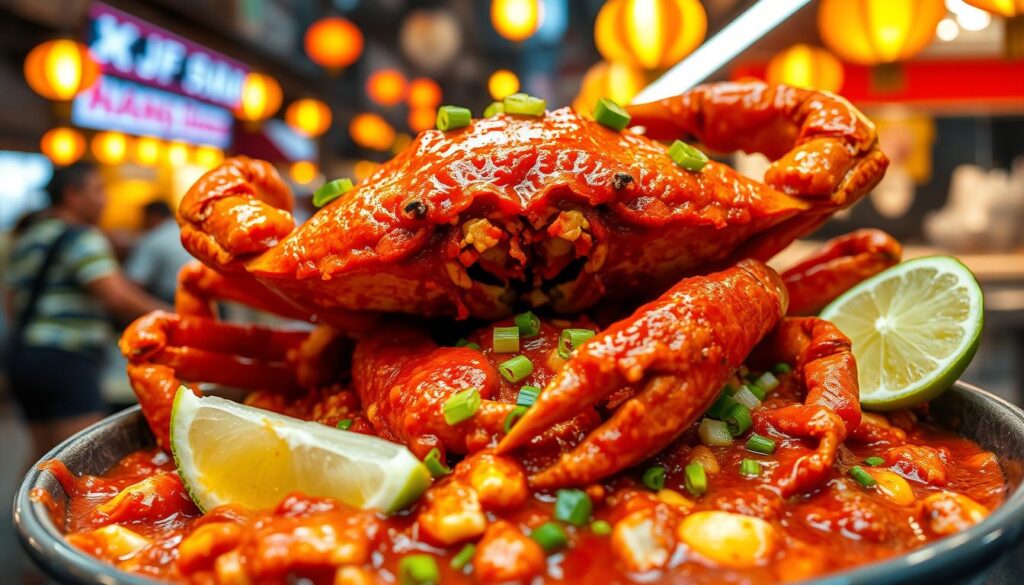
The dish’s sauce is its star, made with tomatoes, chili, and a hint of egg for creaminess. It’s served with mantou buns, perfect for soaking up every last drop. Eating chili crab is a hands-on experience, so don’t be afraid to get messy.
How to Eat Chili Crab Like a Local
Locals know the best way to enjoy chili crab is to dive in with your hands. Use a crab cracker for the claws and savor the tender meat. Pair it with a cold drink to balance the heat.
For a complete meal, order sides like stir-fried vegetables or fried rice. Sharing is common, so bring friends or family. Pro tip: Visit during off-peak hours to avoid long waits.
Best Places to Enjoy Chili Crab
Singapore is home to several renowned restaurants and stalls serving chili crab. Here are a few top picks:
- Jumbo Seafood: Known for its riverfront views and award-winning chili crab.
- Red House: A 1976 original located at East Coast Park, offering a nostalgic vibe.
- No Signboard: Famous for its white pepper crab, a delicious alternative to chili crab.
Prices can vary based on market rates, ranging from $50 to $100 SGD per crab. Many places offer set menu deals, ideal for groups. For premium venues, make reservations in advance.
Whether you prefer the classic chili style, the peppery kick of black pepper crab, or the creamy richness of salted egg crab, there’s a version for every palate. This dish is a true testament to Singapore’s culinary creativity.
Hainanese Curry Rice: A Comfort Food Classic
Hainanese curry rice is a dish that brings warmth and nostalgia to every bite. This hearty meal combines fragrant rice with a rich curry sauce, tender meats, and flavorful sides. It’s a favorite among locals and a must-try for anyone exploring Singapore’s culinary scene.
The History of Hainanese Curry Rice
This dish has its roots in Hainan, China, but evolved in Singapore to include local flavors. It’s a perfect example of how street food traditions adapt over time. Today, it’s a staple at many hawker stalls and food courts, offering a taste of history in every bite.
Where to Get Authentic Hainanese Curry Rice
For an authentic experience, visit Loo’s Hainanese Curry Rice in Tiong Bahru. Established in 1946, this stall is a local legend. Another great option is Hainan Curry Rice in Bukit Merah, where meals start at just $3.50 SGD. For a modern twist, try Select Catering, known for its chicken cutlet version.
Here’s a quick guide to plating styles and combos:
- Separated vs Smothered: Some stalls serve the curry separately, while others smother the rice and meat in sauce.
- Pork Chop + Braised Egg: A classic combo that balances flavors and textures.
- Self-Service Condiment Bars: Add extras like pickled vegetables or chili sauce to customize your meal.
Most stalls close early, often by 3 pm, so plan your visit during peak hours to avoid missing out. Whether you’re a first-time visitor or a long-time fan, Hainanese curry rice is a dish that never disappoints.
| Stall | Location | Specialty |
|---|---|---|
| Loo’s Hainanese Curry Rice | Tiong Bahru | Traditional recipe since 1946 |
| Hainan Curry Rice | Bukit Merah | Budget-friendly at $3.50 SGD |
| Select Catering | Various Locations | Modern twist with chicken cutlet |
Char Kway Teow: Stir-Fried Noodles at Their Best
Char Kway Teow is a dish that embodies the essence of Singapore’s hawker culture. This stir-fried noodle dish is a favorite among locals and a must-try for visitors. Its smoky aroma and rich flavors make it a standout in any food centre.
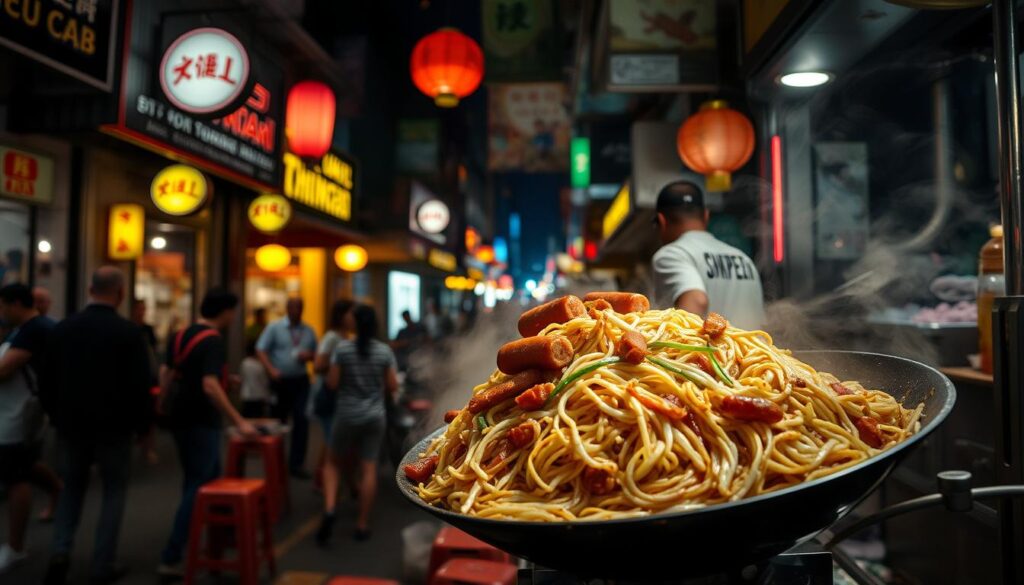
What sets Char Kway Teow apart is its preparation. The dish is cooked over high heat, giving it a distinct wok hei (breath of the wok) flavor. Ingredients like flat rice noodles, eggs, Chinese sausage, and cockles come together to create a savory masterpiece.
What Makes Char Kway Teow Special
The secret to its appeal lies in its balance of textures and flavors. The noodles are soft yet slightly chewy, while the sauce is a mix of sweet and savory. Some stalls add a smoky touch, while others focus on a sweeter profile. It’s a dish that caters to diverse palates.
However, it’s worth noting that Char Kway Teow can be high in cholesterol due to ingredients like lard and egg. For those watching their intake, sharing a portion is a great idea. This also allows you to try other dishes at the stalls.
Top Char Kway Teow Stalls
Singapore is home to several iconic Char Kway Teow stalls. Here are a few you shouldn’t miss:
- Outram Park Fried Kway Teow: A Michelin-recommended stall known for its long queues and exceptional flavors.
- Hill Street Fried Kway Teow: Uses a 50-year-old charcoal fire, adding a unique smoky flavor to the dish.
- Zion Road Stall: Offers generous portions starting at just $4 SGD, making it a favorite among budget-conscious diners.
These stalls are conveniently located near tourist areas, making them easy to visit during off-peak hours. For more recommendations, check out this guide to the best Char Kway Teow in.
| Stall | Location | Specialty |
|---|---|---|
| Outram Park Fried Kway Teow | Hong Lim Market | Michelin-recommended |
| Hill Street Fried Kway Teow | Chinatown Complex | Charcoal-fired |
| Zion Road Stall | Zion Riverside Food Centre | Budget-friendly |
Whether you’re a first-time visitor or a seasoned foodie, Char Kway Teow offers a taste of Singapore’s culinary heritage. Its rich flavors and cultural significance make it a dish worth savoring.
Bak Kut Teh: Pork Ribs in Herbal Broth
Bak Kut Teh, a comforting bowl of pork ribs in herbal broth, is a dish that warms the soul. This aromatic meal is a favorite among locals and a must-try for anyone exploring Singapore’s culinary scene. Its rich flavors and health benefits make it a standout choice for any meal.
The Health Benefits of Bak Kut Teh
This dish is more than just delicious—it’s packed with health benefits. The herbal broth is made with ingredients like garlic, star anise, and dang gui, known for their medicinal properties. It’s believed to boost immunity, improve digestion, and even relieve fatigue.
Broth clarity is a key quality indicator. A clear, golden broth suggests careful preparation and high-quality ingredients. Pair your meal with you tiao (fried dough) for dipping—it’s a local favorite that adds a delightful crunch.
Top Bak Kut Teh Restaurants
For an authentic experience, visit these iconic restaurants:
- Founder Bak Kut Teh: Established in 1978, this spot is famous for its peppery broth and tender pork ribs.
- Ng Ah Sio: A Michelin Bib Gourmand recipient, known for its robust flavors and generous portions.
- Song Fa: Offers a premium pork loin version, perfect for those seeking a modern twist.
Many of these places offer free refill policies, ensuring you never run out of broth. While some are located in the CBD, others are GPS-worthy destinations outside the city center. Visit during off-peak hours to avoid long waits.
Roti Prata: A Flaky Indian Flatbread
Roti Prata, a flaky Indian flatbread, is a beloved staple in Singapore’s diverse culinary landscape. This dish, with its crispy layers and rich flavors, has become a favorite among locals and visitors alike. Whether enjoyed plain or with creative fillings, Roti Prata offers a versatile and satisfying meal.
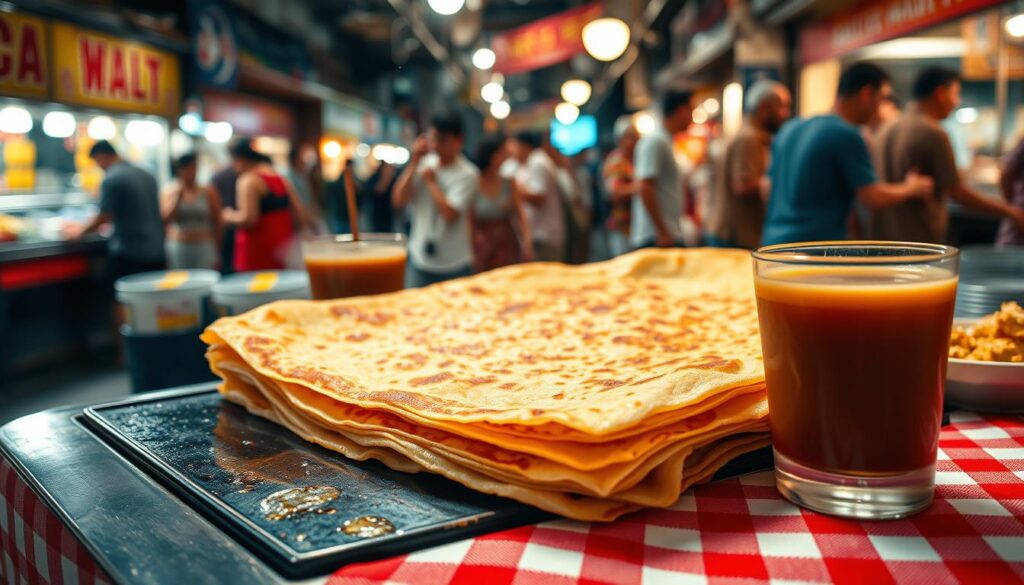
How Roti Prata is Made
The process of making Roti Prata is both an art and a science. Dough is stretched thin, folded, and cooked on a hot griddle until golden and crispy. The result is a flaky, buttery flatbread that pairs perfectly with curry or sugar.
Some stalls add unique twists, like cheese, mushroom, or even chocolate fillings. These variations cater to diverse tastes, making Roti Prata a dish that appeals to everyone.
Where to Find the Best Roti Prata
Singapore is home to several iconic stalls and food courts serving Roti Prata. Here are a few top picks:
- The Roti Prata House (Upper Thomson): Open 24 hours, this spot is perfect for late-night cravings.
- Mr. & Mrs. Mohgan’s Super Crispy Prata: Known for its affordable prices, starting at just $1.30 SGD.
- Springleaf Prata Place: Offers creative fillings like cheese and mushroom, adding a modern twist to the classic dish.
For a cultural experience, compare the Jalan Kayu and Little India clusters. Jalan Kayu is famous for its traditional stalls, while Little India offers a vibrant atmosphere and unique flavors.
Pair your Roti Prata with teh tarik (pulled tea) for a complete meal. This combination is a favorite among locals and adds an authentic touch to your dining experience.
Keep in mind that some places can get crowded during late-night hours. Plan your visit accordingly to avoid long waits and enjoy this iconic dish at its best.
Satay: Grilled Meat Skewers
Grilled to perfection, satay skewers are a flavorful highlight of local cuisine. These marinated meat skewers, often served with peanut sauce, are a favorite among locals and visitors alike. Satay is more than just a dish—it’s a cultural experience that brings people together.
The Art of Making Satay
Creating satay is a skill that combines tradition and technique. The meat, usually chicken, beef, or mutton, is marinated in a blend of spices like turmeric, lemongrass, and cumin. It’s then grilled over charcoal, giving it a smoky flavor known as wok hei.
For the perfect satay, timing is key. Overcooking can dry out the meat, while undercooking leaves it tough. The peanut sauce, made with ground peanuts, chili, and lime, adds a creamy, tangy finish. Pair it with cucumber and onion for a refreshing contrast.
Top Satay Stalls in Singapore
Singapore is home to several iconic satay spots. Here are a few you shouldn’t miss:
- Lau Pa Sat Satay Street: A tourist-friendly hub with a lively atmosphere.
- Chomp Chomp Satay: A Michelin-recommended stall known for its quality and flavor.
- Satay by the Bay: Located near Gardens by the Bay, this spot offers a scenic dining experience.
Prices typically start at $15 SGD for 20 sticks, making it an affordable treat. Many stalls are halal-certified, catering to diverse dietary needs. For the best experience, visit during late-night hours when the stalls are bustling with energy.
Whether you’re exploring a food centre or a heritage hawker, satay is a dish that promises to delight. Its rich flavors and cultural significance make it a must-try in Singapore’s culinary landscape.
Kaya Toast: A Sweet Breakfast Treat
Kaya toast is a delightful breakfast staple that has captured the hearts of many. This simple yet satisfying dish features crispy toast slathered with kaya, a rich coconut and egg jam. Paired with soft-boiled eggs and coffee, it’s a morning ritual cherished by locals and visitors alike.
Kaya toast comes in two main styles: thick and thin. Thick toast offers a hearty crunch, while thin toast is light and crispy. Some cafes even add a modern twist with pandan kaya, infusing the spread with a fragrant, green hue. Set meal deals often include coffee or tea, making it an affordable and complete breakfast option.
The Perfect Pairing: Kaya Toast and Coffee
Kaya toast is best enjoyed with a cup of local coffee. The creamy sweetness of the kaya complements the bold, aromatic flavors of the brew. Many cafes serve this combo as a set meal, perfect for a quick and satisfying start to the day.
For an authentic experience, dip your toast into soft-boiled eggs seasoned with soy sauce and white pepper. This classic combination is a favorite among locals and adds a savory touch to the meal.
Best Kaya Toast Cafes
Singapore is home to several iconic spots for kaya toast. Here are a few you shouldn’t miss:
- Tong Ah Eating House: A 1939 original, this spot is known for its traditional recipe and cozy atmosphere.
- Chin Mee Chin: Step back in time with its retro 1920s decor and freshly baked toast.
- Heap Seng Leong: Budget-friendly at just $1.50 SGD, this spot is a hidden gem for kaya toast lovers.
Many of these cafes close early, often by 3 pm, so plan your visit during peak hours to avoid missing out. Whether you’re exploring a food court or a heritage restaurant, kaya toast offers a taste of Singapore’s culinary heritage.
Carrot Cake: Not What You Think
Carrot cake in Singapore is a savory delight, not the sweet dessert you might expect. Made with radish and rice flour, this dish is a staple in hawker stalls and food centres. Its unique flavors and textures make it a must-try for anyone exploring local cuisine.
The Difference Between Black and White Carrot Cake
There are two main styles of carrot cake: black and white. The white version is stir-fried with eggs, garlic, and preserved radish, offering a light and fluffy texture. The black version, on the other hand, is cooked with sweet soy sauce, giving it a richer, caramelized flavor.
Some locals prefer the crispy edges of the black version, while others enjoy the softness of the white. Both styles are delicious, but they cater to different palates. Pair your carrot cake with a chili and fish sauce combo for an extra kick.
Where to Try Authentic Carrot Cake
For an authentic experience, visit these iconic stalls:
- Zion Road Carrot Cake: Known for its affordable prices, starting at just $3 SGD.
- Lau Goh Teochew Chye Thow Kway: A 40-year-old family recipe that’s stood the test of time.
- Hill Street Fried Kway Teow: A Michelin-recommended stall offering a unique smoky flavor.
Most stalls are located in Chinatown Complex, making them easy to access during peak hours. However, be warned: some stalls run out of stock by mid-morning, so plan your visit early.
| Stall | Location | Specialty |
|---|---|---|
| Zion Road Carrot Cake | Zion Riverside Food Centre | Affordable at $3 SGD |
| Lau Goh Teochew Chye Thow Kway | Chinatown Complex | 40-year-old recipe |
| Hill Street Fried Kway Teow | Chinatown Complex | Michelin-recommended |
Whether you prefer the crispy black version or the soft white one, carrot cake is a dish that promises to delight. For more recommendations, check out this guide to the best local dishes in Singapore.
Oyster Omelette: A Seafood Lover’s Dream
Oyster omelette is a savory dish that seafood enthusiasts can’t resist. This iconic meal combines plump oysters with fluffy eggs, creating a rich and satisfying flavor. It’s a staple in many hawker centers and a favorite among locals.
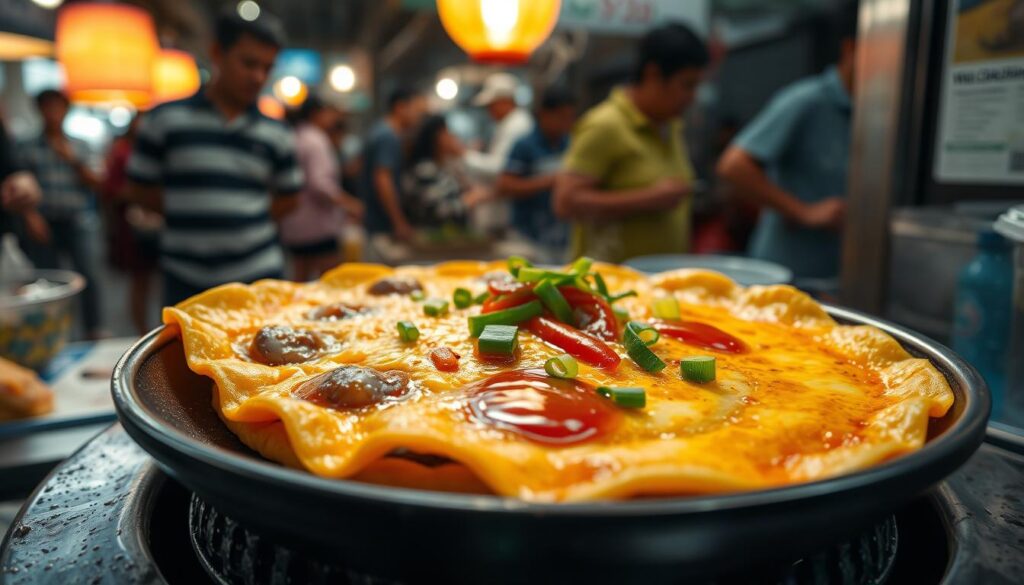
How Oyster Omelette is Prepared
The dish starts with fresh oysters, which are lightly battered and pan-fried with eggs. A starch slurry is added to create a crispy texture, while a blend of garlic, soy sauce, and chili enhances the flavor. The result is a perfect balance of crispy edges and tender oysters.
Some stalls add a modern twist by using premium ingredients or unique sauces. Whether you prefer it crispy or gooey, oyster omelette is a dish that caters to diverse tastes.
Top Oyster Omelette Stalls
Here are a few iconic spots to try:
- Ah Chuan Fried Oyster: A Michelin Plate recipient, known for its generous portions and fresh oysters.
- Hup Kee: With a 60-year-old recipe, this stall offers a nostalgic taste of tradition.
- Ang Sa Lee: A premium option at $6 SGD, perfect for those seeking a gourmet experience.
For a unique experience, compare the Katong and Geylang areas. Katong is known for its heritage stalls, while Geylang offers a lively atmosphere. Sharing portions is a great way to try more dishes without overeating.
Quality can vary depending on the day, with weekdays often offering fresher ingredients. Also, note that many stalls operate on a cash-only policy, so come prepared.
Popiah: Fresh Spring Rolls
Popiah, a fresh spring roll, is a light and flavorful dish that stands out in Singapore’s culinary scene. This delicate wrap is filled with fresh ingredients like jicama, carrots, and tofu, creating a perfect balance of textures and flavors. It’s a favorite among locals and a must-try for anyone exploring the city’s diverse food culture.
The Ingredients That Make Popiah Unique
What sets popiah apart is its combination of fresh and savory elements. The wrap is made from a thin, soft crepe, while the filling includes jicama, carrots, tofu, and sometimes shrimp or pork. A drizzle of sweet sauce and a sprinkle of crushed peanuts add the finishing touch.
For those who enjoy customization, many stalls offer chili paste on the side. This allows you to adjust the spice level to your preference. Vegetarian-friendly versions are also available, making it a versatile dish for all dietary needs.
Best Places to Enjoy Popiah
Singapore is home to several iconic spots for popiah. Here are a few you shouldn’t miss:
- Kway Guan Huat: A Michelin Bib Gourmand recipient, known for its traditional recipe and DIY options.
- Ji Xiang Popiah: Affordable at just $2 SGD, this stall is a favorite among budget-conscious diners.
- Old Long Popiah: Established in 1936, this spot offers a nostalgic taste of heritage.
Many of these food centres are located along East Coast Road, making them easy to access during peak hours. Whether you prefer pre-rolled or DIY versions, popiah is a dish that promises to delight.
| Stall | Location | Specialty |
|---|---|---|
| Kway Guan Huat | East Coast Road | Michelin Bib Gourmand |
| Ji Xiang Popiah | Chinatown Complex | Affordable at $2 SGD |
| Old Long Popiah | East Coast Road | Established in 1936 |
For a unique experience, try the DIY version at Kway Guan Huat. It’s a fun way to customize your popiah and enjoy it just the way you like. Whether you’re a first-time visitor or a long-time fan, this dish is a true star of Singapore’s culinary heritage.
Ice Kachang: A Refreshing Dessert
Ice Kachang is a colorful and refreshing dessert that’s perfect for beating the heat. This shaved ice treat is a beloved classic in Singapore’s dessert scene, offering a delightful mix of textures and flavors. Whether you’re a local or a visitor, it’s a must-try for anyone with a sweet tooth.
The Components of Ice Kachang
At its core, Ice Kachang is made with finely shaved ice, topped with a variety of sweet ingredients. Common additions include red beans, sweet corn, grass jelly, and attap chee (palm seeds). A drizzle of colorful syrups and condensed milk ties everything together, creating a vibrant and Instagram-worthy presentation.
For an extra twist, some stalls offer add-ons like aloe vera, nata de coco, or even durian. Seasonal variations, such as mango, are also popular. Each bite is a burst of sweetness and crunch, making it a satisfying treat for any time of day.
Where to Find the Best Ice Kachang
Singapore is home to several iconic spots for this dessert. In Chinatown, you’ll find traditional versions at Annie’s Peanut Ice Kachang, where a bowl costs just $1.80 SGD. Over in Bugis, Dessert Bowl offers a durian-infused version for those who love bold flavors.
For a Michelin-approved experience, head to Jin Jin Dessert. Known for its quality and creativity, this spot is a star among dessert lovers. Many of these places are located in bustling food courts, making them easy to access during peak hours.
Whether you’re exploring Chinatown or Bugis, Ice Kachang is a dessert that promises to delight. Its refreshing flavors and vibrant presentation make it a true highlight of Singapore’s culinary heritage.
Conclusion: Exploring the Best Street Food in Singapore
Exploring the vibrant flavors of Singapore’s culinary heritage is an unforgettable journey. From the iconic chicken rice to the savory carrot cake, each dish tells a story of cultural harmony and tradition. These meals are not just about taste but also about preserving a rich heritage that defines this city.
When visiting hawker centers, remember to follow local etiquette. Order with a smile, be patient during peak hours, and always return your tray. To navigate easily, use the MRT map to locate major centers like Lau Pa Sat and Maxwell Food Centre.
Lastly, embrace sustainable tourism practices. Support local vendors, reduce waste, and respect the culture. By doing so, you contribute to the preservation of Singapore’s street food legacy for future generations to enjoy.

